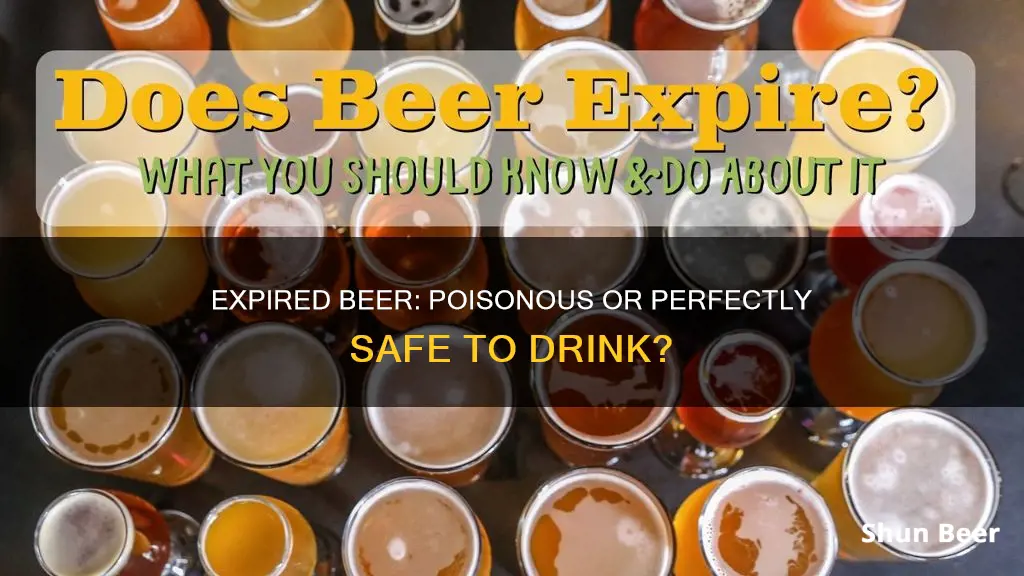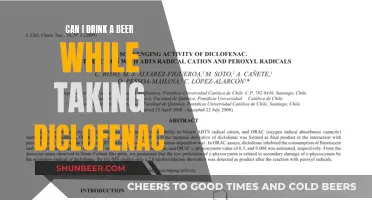
Drinking expired beer is harmless. It is extremely unlikely to make you sick, and you certainly won't die from it. The worst that will happen is that it will taste bad. The flavour of beer degrades over time due to exposure to light, oxygen, and heat, but this only affects the taste, not safety. In fact, some beers, like stouts and barley wines, are brewed with the intent that they will be aged. So, while drinking expired beer is not dangerous, it may not be a pleasant experience.
| Characteristics | Values |
|---|---|
| Can you die from drinking expired beer? | No, drinking expired beer is harmless and non-toxic. |
| Why can't you die from drinking expired beer? | Beer is pasteurized or filtered to eliminate bacteria. It also has a low pH level and alcohol content, making it an unfriendly environment for microorganisms. |
| What does expired beer taste like? | It might not taste good, and it's likely to smell odd and taste stale or flat. |
| How to identify expired beer? | Check for an absence of the signature hissing sound when you open it, which means the beer has lost its carbonation. Also, inspect the label to check if it's dusty – this is a good indication that the beer has been sitting on the shelf for a while. |
| How to prolong the shelf life of beer? | Store it in a dark place, out of direct sunlight, and upright at the right temperature. |
What You'll Learn

Drinking expired beer is harmless
Beer is similar to wine in that it ages even after bottling. Unlike wine, however, the taste of beer gets worse over time rather than better. The decrease in taste is due to three factors: hops, light, and oxygen. Hops are one of the more delicate characteristics of beer and are the first to show signs of aging. Light, specifically ultraviolet (UV) rays, can cause the hop-derived compounds in beer to break down and combine with a sulphuric compound, resulting in a skunky taste and smell. Finally, oxygen interacts with the compounds from malt, yeast, and hops, causing oxidation and a disappointing papery or wet cardboard taste.
To prolong the shelf life of beer, it is recommended to store it in a dark place, out of direct sunlight, and at the right temperature. Storing beer upright can also help minimize oxidation. While the ideal temperature varies based on the type of beer, standard beers like IPAs or stouts are usually stored at 50 to 54°F (10 to 12°C), while lighter beers like pilsners and lagers should be stored cooler. Canned beer is also likely to last longer than bottled beer as it is airtight and blocks out direct sunlight, oxygen, and other impurities.
Beer Shampoo: Safe to Drink?
You may want to see also

Beer's expiration date is a guideline
Beer does expire, but it doesn't spoil in the same way that other foods do. The expiration date on beer is more of a guideline than a hard-and-fast rule, and it's primarily focused on ensuring the best taste and quality. Here's why:
Firstly, beer is a perishable product that is susceptible to staling when exposed to light, oxygen, and heat. These elements can degrade the organic compounds that give beer its distinctive flavour and aroma. However, even when its flavour declines, beer is typically safe to consume. Most beer is pasteurized or filtered to eliminate bacteria, making it highly resistant to spoilage.
Secondly, the alcohol content in beer acts as a natural preservative, inhibiting bacterial growth. Additionally, hops, which are commonly used in brewing, have antimicrobial characteristics that further prevent pathogenic growth. As a result, the worst-case scenario with expired beer is usually a change in taste rather than any health risks.
That being said, different styles of beer can have varying shelf lives. High-alcohol, malt-forward beers like barley wines and imperial stouts are sometimes brewed with aging in mind. These beers can develop more complex flavours over time, and brewers intend for them to be aged for a couple of years. On the other hand, hop-heavy styles like IPAs are best enjoyed fresh, as the delicate hop characteristics can fade within a few months.
The packaging and storage conditions also play a significant role in beer's shelf life. Sealed beer can generally last 6 to 8 months without refrigeration, and even longer when stored properly in a cool, dark place. Opened beer, on the other hand, has a much shorter lifespan as it starts to go flat once the airtight seal is broken.
In summary, while beer does have an expiration date, it is primarily a guideline to ensure optimal taste and quality. Drinking expired beer is generally harmless, but the flavour and aroma may deteriorate over time. To prolong the shelf life of your beer, it's best to store it in a cool, dark place, away from direct sunlight, and consume it as close to the packaging date as possible.
Mixing Beer and Xanax: What You Need to Know
You may want to see also

Beer is perishable
The fermentation process used in brewing, as well as its low pH level and alcohol content, make beer an unfriendly environment for microorganisms, meaning it is extremely resistant to spoiling. However, this does not mean that beer is impervious to degradation. Beer is perishable, and its flavour will change over time.
The hops in beer are sensitive to light and can become "light struck", a chemical reaction that gives off an unpleasant skunky taste. This is why beer is usually packaged in dark bottles or aluminium cans, which block out UV rays. However, this is not always the case, and some beers are packaged in clear or green glass bottles, which offer little to no protection against UV rays. Therefore, it is important to store beer in a cool, dark place, preferably a refrigerator, to prevent degradation.
Oxidation is another factor that affects the flavour of beer. Oxygen interacts with the compounds from malt, yeast, and hops, causing oxidation and a disappointing papery or wet cardboard taste. This process is accelerated once the beer is opened, and if left out, the beer will be a sad version of its former self.
Heat also speeds up oxidation, so it is important to store beer in a refrigerator. Major changes in temperature, such as going from an ice-cold cooler to a hot car, can also cause the beer to spoil.
While drinking expired beer is generally harmless, it is important to note that the taste will be affected. The beer may taste flat, sweet, or malty, and may have lost its characteristic bitterness and bright hops flavour. Therefore, it is recommended to consume beer as close to its packaging date as possible to enjoy it at its freshest.
Should Large Dogs Drink Beer?
You may want to see also

Beer's taste and smell change over time
Beers' Taste and Smell Change Over Time
Beers' taste and smell change over time due to several factors, including oxidation, heat, light exposure, and bacterial growth. Here's how these factors affect beer:
Oxidation:
Oxidation occurs when oxygen molecules interact with the molecules in the beer and its ingredients, causing chemical reactions that alter the flavour and aroma compounds. This results in stale or flat-tasting beer with a disappointing papery or wet cardboard taste. Oxidation happens faster once the beer is opened and is exposed to more oxygen.
Heat:
Heat accelerates the oxidation process, making it crucial to store beer in a cool place, preferably a refrigerator. Major temperature fluctuations, such as moving beer from an ice-cold cooler to a hot car, can also negatively impact the beer's taste.
Light Exposure:
Light exposure, especially to ultraviolet (UV) rays, can cause the hop-derived compounds in beer to break down and combine with sulphuric compounds. This results in the release of a skunk-like odour and a taste reminiscent of soggy cardboard. Clear and green glass bottles offer little to no protection against UV rays, while brown glass bottles provide the best defence. However, aluminium cans are superior at blocking out UV rays.
Bacterial Growth:
Although rare, bacterial infections in beer can occur. Unpasteurised craft beer is more susceptible to bacterial growth and should be consumed fresh. Refrigeration can help slow down the growth of microbes like yeast, prolonging the shelf life of unpasteurised beer.
Other Factors:
Other factors that contribute to beer staling include the distance travelled from the brewery, packaging, and temperature fluctuations during storage and retail. Beer packaged in aluminium cans or brown glass bottles tends to stay fresher due to better protection from sunlight and oxygen. Storing beer upright instead of on its side also minimises oxidation by reducing the surface area exposed to air.
To summarise, while drinking expired beer is generally harmless, the taste and smell will change over time due to oxidation, heat, light exposure, and bacterial growth. To prolong the shelf life of your beer, store it in a cool, dark place, preferably in a refrigerator, and consume it as close to the packaging date as possible.
Drinking Beer in Venice: What's Allowed in Public?
You may want to see also

Proper beer storage
Beer is a perishable product that can be stored and aged, but it will eventually go stale. The flavour and aroma of beer degrade over time when exposed to light, oxygen, and heat. However, even when its flavour declines, beer can still be safe to drink. The alcohol and hops in beer prevent bacterial growth that can cause sickness, so the worst thing that can happen with old beer is that it will taste bad.
Store Beer Upright
It is recommended to store beer upright instead of on its side. This ensures that the yeast settles at the bottom of the bottle, rather than leaving a ring or watermark on the side that won't settle or mix. Storing beer upright also minimises the amount of surface area that will be in contact with the air, reducing oxidation and helping the beer stay fresh for longer.
Keep Beer Away from Light
Beer should be stored in a dim or dark location, as ultra-violet and blue light can spoil beer. This can cause the beer to become "light struck" and develop a "skunky" taste. Green and brown bottles can help protect the beer from becoming light struck.
Maintain Optimal Temperature
Beer should be stored at cool temperatures, ideally between 50°F and 55°F (10°C-12.8°C). The specific temperature depends on the type of beer:
- Strong, high-alcohol beers (such as barley wines, triples, and dark ales) can be stored at room temperature (55°F-60°F/12.8°C-15.5°C).
- Standard, mid-range alcohol ales (such as bitters, IPAs, lambics, stouts, etc.) should be stored at cellar temperature (50°F-55°F/10°C-12.8°C).
- Lighter, low-alcohol beers (such as lagers, pilsners, wheat beers, milds, etc.) should be stored in a refrigerator (45°F-50°F/7.2°C-10°C).
Check Expiration Dates
Beer has a shelf life of about 3-6 months before its quality starts to degrade. However, some beers, such as vintage beers, barley wines, and imperial stouts, can benefit from extended aging. If you plan to age your beer, buy at least two bottles: one to drink immediately to compare the fresh taste with the aged one.
Avoid Extreme Temperatures
Avoid storing beer in extremely hot or cold temperatures, as it can destroy the flavour and increase the risk of the container exploding.
Underage Beer Drinking: Exploring the Legal Drinking Age Limits
You may want to see also
Frequently asked questions
No, drinking expired beer will not kill you. Beer is resistant to spoiling as the fermentation process, low pH level, and alcohol content make it difficult for bacteria to survive and thrive. However, drinking expired beer could result in a mild upset stomach.
The taste of expired beer will differ from that of fresh beer. The organic compounds that make beer smell and taste great degrade over time, resulting in a flatter, sweeter, and more malty flavour.
There are a few ways to tell if beer has expired. Firstly, check if there is an absence of the signature hissing sound when opening it, indicating that the beer has lost its carbonation. Secondly, look for any dust on the bottle, which could suggest it has been sitting on the shelf for a while. Lastly, take a sip and assess the taste; expired beer will often taste flat and stale.







